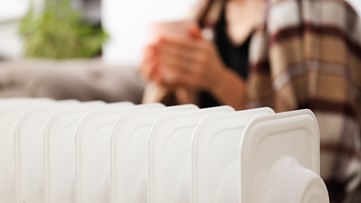A popular trend online shows people using terracotta clay pot “heaters” in an attempt to save money on heating their homes. The homemade device consists of an upside-down terracotta pot propped up over household candles.
Multiple VERIFY viewers, including Karen and Bob, reached out to ask if heating a room using candles and a terracotta pot actually works and whether it's safe.
THE QUESTION
Are clay pot heaters a safe way to heat a room?
THE SOURCES
THE ANSWER
No, clay pot heaters are not a safe way to heat a room.
WHAT WE FOUND
A clay pot heater may make you feel warmer if you sit close to it, but experts say it won’t do much to warm the room as a whole and it’s also a serious fire risk.
Typically, when you burn a candle, the heat from the candle rises up to the ceiling. Placing a clay pot over the candle may trap the heat lower to the ground, radiating the heat in different directions that may be closer to you, E. Dan Dahlberg, Ph.D., physics professor at University of Minnesota said.
“The heat released from chemically burning candle wax will not change with the clay pot being present or not, so it should have no effect on the total energy released,” Scott Schiffres, Ph.D., associate mechanical engineering professor at Binghamton University explained.
“If you’re close to the pot, it would feel warmer, but it’s hard to imagine it would make any difference in the overall temperature of the room,” Dahlberg added.
Most importantly, it's not a safe method to stay warm this winter.
Terracotta is a clay pot material that can heat up to dangerously hot temperatures. This can pose a burn risk, John Smith, director of the Fire Risk Assessment Network, said. High temperatures can also cause the terracotta pot to crack or even explode as the material is porous and “moisture trapped within the clay can heat rapidly.”
Clay pot heaters can also be dangerous because of fire hazards associated with the use of candles.
Videos of clay pot heaters often show tea candles being placed in close proximity on a tray, but the National Candle Association says you should “place burning candles at least three inches apart from one another.” This is to avoid candles melting each other or creating a draft that could cause the candles to burn improperly.
Some videos of the homemade heater show users placing the clay pot directly on top of the candles, with no added stability. The U.S. Fire Administration says lit candles should be in stable holders and placed in an area where they cannot be knocked down easily. Placing candles in an unstable environment can cause a fire.
The London Fire Brigade also issued a warning about this clay pot heater trend, adding that “a small gust of wind can cause an innocent candle flame to set light to objects nearby if left too close.”
In the statement, Station Manager Charlie Pugsley calls the clay pot heating method unsafe and said, “As a fire investigator, I see dozens of fires every year, including fatal fires, that are caused by people using alternative forms of heating and lighting, most of which include a naked flame.”
In December 2022, Derbyshire Fire & Rescue Service also reported a fire that happened as a result of the homemade heating device. Fire investigator Barclay Masterson said in a statement, “The heat released from the base of the tea lights was enough to weaken the terracotta plates they were placed on, causing the homemade device to collapse and the melted wax to ignite.”
If you are having trouble paying for your heating, there are government assistance programs, such as the Low Income Home Energy Assistance Program, that may be able to help you. Learn more about the resources available on the USA.gov website. Your state may also be able to provide additional resources.













